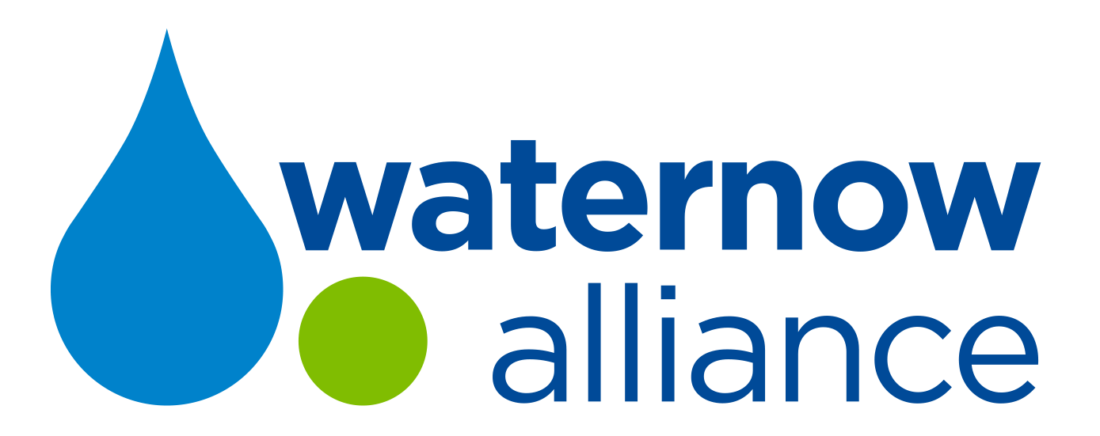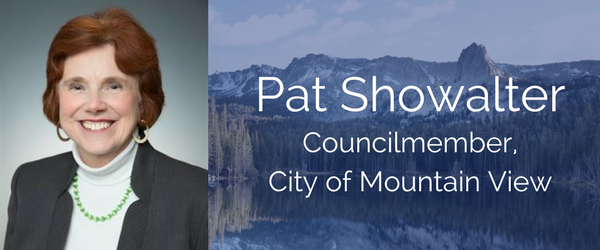Pat Showalter is no stranger to the water sector. Pat is a professional engineer with more than 30 years of water resources management experience at the federal, state, and local government levels. Most recently, she has played two very important roles in the municipal water realm. She worked as a Senior Project Manager at Santa Clara Valley Water District (SCVWD) for 15 years before retiring this past May and she currently serves as a Councilmember for the City of Mountain View. Pat has been a WaterNow Alliance Member since 2015 and we recently welcomed her as the newest member of WNA’s Steering Committee.
I spoke with Pat about her career in water and her leadership efforts on the San Francisco Bay Salt Pond Restoration Project.
What initially compelled you to pursue a career in water? And how did your career progress?
I was a geology major in college and I was honestly just kind of disgusted with my major. I made this long list of all the things that I liked and they all had something to do with water. I went to Princeton for a semester and took hydrology and I loved it. I was hooked.
I went to UC Berkeley for Graduate School and went to work for a subsidiary of Water Resource Engineering, Inc. I got to work with Harvey Banks, the first director of the Department of Water Resources, so that was quite an awe-inspiring period for me.
Then I went to work for the US Geological Survey (USGS) as a hydrologist there for about 8 years before taking some time off to have kids. That’s when I first got very involved in my local community. One of the jobs I volunteered for was the Environmental Planning Commission. I learned a tremendous amount being involved in land use changes and water issues in Mountain View during the dot-com boom.
When I went back to work, my first job was running the San Francisquito Creek Watershed Council. I took the reins right before the ‘98 flood hit so that turned out to be quite a job. And finally, I landed at SCVWD for 15 years as a Senior Project Manager.
What do you think are the biggest changes in sustainable water resource management in CA over the course of your career?
I’ve seen a huge change in the attitude toward the use of recycled or reclaimed water, and also the importance of sustainable groundwater management. To have that legislation finally passed in 2014 was huge.
I also think that as time has gone on, water conservation has been something that people in California all really believe in. There are now numerous efficiency measures included in the state building code - a house that’s constructed now uses almost half the water of a house constructed in the 70s or 80s. That’s amazing!
What made you decide to run for local office? Was your interest in water a primary factor or were you mainly motivated by other issues?
You know, even though I work for a water utility, water supply was not a primary factor for me. On a personal level, one of my main motivations was to institute the sea level rise protection that’s needed for my community. Another issue that has always been incredibly meaningful for me is housing. The lack of housing and all of the issues it raises is the biggest source of our local environmental problems – the traffic, greenhouse gases, and other associated issues. In Mountain View we have a tradition of really stepping up when it comes to housing, and I wanted to support that.
You were in a fairly unique position, serving as both water utility staff and a city councilmember. What value do you think that staff and electeds bring to the equation?
Staff members are experts in various fields, so when they bring us something it’s from their expert view. But as elected officials, we represent the voice of the people and the values of our community. Sometimes those values are stronger, not as strong, or slightly different from what the staff might bring forward. I think the staff work very hard to align their suggestions with the Board’s values and they do a really good job.
It’s so important to have people on boards who have different expertise themselves so they can apply that knowledge. Right now, we have two environmental professionals on the board and all of our fellow board members really respect that expertise.
I really believe in the value of our public works. I’m able to champion the use of recycled water, improving the building code, and making sure everyone’s aware of the value of the Salt Ponds.
You’ve been an advocate for environmentally-conscious solutions to water management challenges throughout your career. How did San Francisco Bay Salt Pond Restoration Project get started and what was your role?
The project started a little over 15 years ago. Over 15,100 acres of Salt Ponds were bought through a collaboration involving Federal, State and local foundation funding. We’re literally taking land that was used as a salt factory and turning it back into marshland, which it hasn’t been for 100 years.
This turned out to be the largest wetland restoration project on the West Coast of the Americas and it’s also on the Pacific Flyway. Since the salt ponds ring the bay edge of Santa Clara County, it’s recognized as one of our best protections against sea level rise. The three prime goals of the restoration project are habitat protection, flood protection, and public access.
My role was to serve on the Project Management Team which is made up of representatives from all of the partner agencies to work through all the operational issues associated with restoring the Salt Ponds. As the SCVWD representative, I brought more of a flood protection point of view to this team.
One of the things that I was proud to provide support on was the scientific investigations. SCVWD stepped up to the plate to fund much of the scientific investigations so I worked closely with the scientists, mainly with the USGS, to make sure that the studies were in-line with what was needed and to understand the results. This was a challenge but it was great fun. I was “the voice of mud”.
Why is restoring the Salt Ponds so beneficial for flood control and storm water?
Marshes are natural sponges. They absorb a great deal of flood or storm surge water by forming a physical barrier. They also dissipate the energy of the waves. Based on the sea level rise modeling that’s been done, if we can get these marshes established within the next 15 years or so, the growth rate of the marshes will be able to keep up with sea level rise.
This means that mother nature and this green infrastructure will provide us with a valuable service and we won’t have to pay to build the infrastructure. But this is time sensitive. It’s very crucial that measure AA was passed and some of the flood protection works are being built so we can start to get the marshes established as quickly as possible.
Have you seen tangible results from the restoration efforts at this point?
We’ve doubled the number of birds that visit the South Bay in the 10 years since the restoration started. We’re also seeing species of fish return in very healthy numbers. To me that’s very exciting. We’ve also created tens of miles of public access trails that are very popular.
Finally, what do you think is the biggest challenge facing local urban water utilities in California today and what are the most promising strategies for addressing this challenge?
On a local level, the biggest challenge will be making the transition away from our dependency on imported water. We have to change the way we value local supply. Right now, imported water is much cheaper than local supply so we really depend on it. As an industry, we need to figure out a better description of the really costs of importing water rather than using local water so we can better evaluate how to make the tough decisions to build recycled water plants or to support other water efficient measures. What are they really worth to us?
One of the things happening in Mountain View and Silicon Valley that makes me very optimistic about this is that our businesses are tripping over each other to come up with the newest, coolest water systems. Think of what Apple has done with their headquarters, they’ve built a purple pipeline from the San Jose treatment plant to their facility to flush all of their toilets! Microsoft has also just redesigned their building to use the most efficient water features possible – they want to be net zero on potable water. Having these people and companies with money, innovation, and intelligence interested in this issue is very positive.
When I first became a civil engineer many years ago, there was a belief that environmental issues were trade-offs, you were trading off between a good economy and having a clean environment. Over the years we found out that that’s not the case at all, the two go hand-in-hand. I think Silicon Valley in particular has demonstrated that we can be economically very successful while reducing our water demand and our environmental footprint at the same time.

